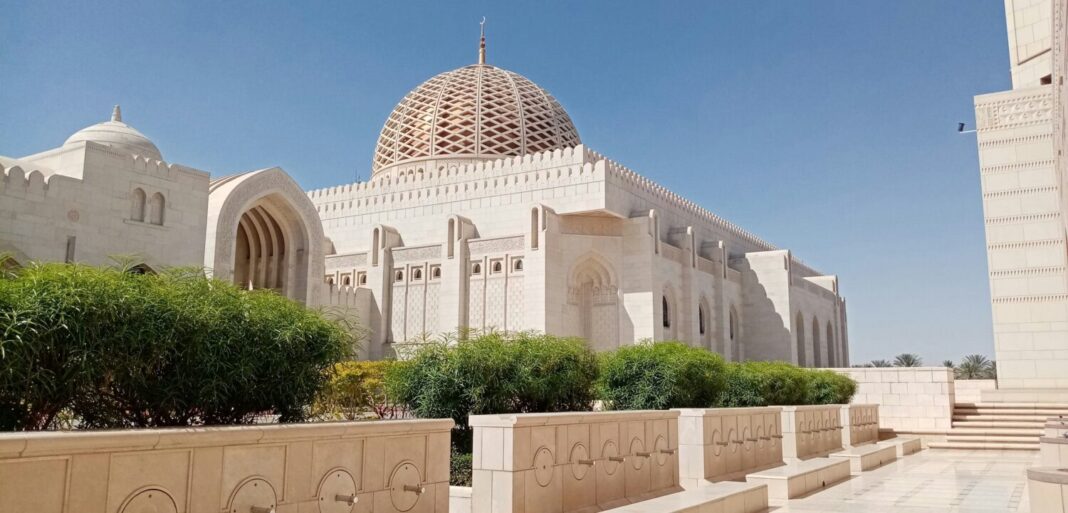Nestled on the Arabian Peninsula, Oman is a land where tradition intertwines with modernity, and its mosques stand as proud beacons of the nation’s cultural richness and architectural prowess. These Islamic edifices range from the grand Sultan Qaboos Grand Mosque to smaller, yet equally captivating structures like the Asma Mosque, each embodying the essence of Omani devotion anShould your travels bring you to this corner of the world, a seamless connection is available via Salam Air Dubai, prod craftsmanship.
viding direct and cost-effective flights to Muscat, among other Omani destinations. What follows is a curated guide to the most remarkable mosques that Oman has to offer—an array of architectural treasures that promise a journey marked by awe and reverence.
- Sultan Qaboos Grand Mosque
A distinguished landmark in Muscat, the Sultan Qaboos Grand Mosque is an example of architectural magnificence. A testament to patience and artistry, its construction spanned seven years and today, it stands capable of welcoming 20,000 worshippers. Beyond its imposing size, it is the mosque’s meticulously crafted details that truly command attention. Among them is the central chandelier—a breathtaking assemblage of Swarovski crystals that cascade light elegantly across the prayer hall.
- Mazoon Mosque
In Mawalih lies the Mazoon Mosque, a structure named in honour of Sultan Qaboos’s mother. It exudes tranquillity and minimalistic beauty, appearing as an oasis of calm. The design celebrates the Islamic tradition of calligraphy, with walls that narrate stories of heritage through every ornate letter and motif inscribed upon them.
- Al Zulfa Mosque
Al Seeb is home to the Al Zulfa Mosque, affectionately known as the “Royal Guards of Oman Mosque,” which promises to enchant it with its geometric excellence and chromatic splendour. Over twenty domes, adorned in hues of green and gold, crown this mosque, while its artistic floor patterns captivate the gaze. A spectrum of colours radiates through glass artwork within the windows, creating a dynamic interplay of light and shadow within.
- Mohammed Al Ameen Mosque
The contemporary Mohammed Al Ameen Mosque, alternatively referred to as the Bahwan Mosque or Bausher Mosque, is a relatively new addition to Oman’s religious landscape, having been completed in 2014. Its architectural design shines under the cover of night, with domes illuminated in warm golden hues, and surrounds that project an ethereal blue glow, enveloping the mosque in an almost celestial atmosphere.
- Al Khor Mosque
Imbued with historical significance, the Al Khor Mosque, historically known as the Masjid Al Shuhadaa or the “Mosque of the Martyrs,” is intimately linked to Oman’s past. It stands as a tribute to those who valiantly resisted Portuguese domination. Known to many as the “Family Mosque,” it continues to serve the Royal Family. Upon entering, one’s eyes are immediately drawn to the dual blue domes and walls gracefully outlined with tinted glass and marble. Most compelling, however, are the golden inscriptions of the 99 names of God, displayed amidst a canvas of blue and white tiles on the ceiling.
- Asma Mosque
For aficionados of Moroccan design, the Asma Mosque in Al Qurum is a visual symphony. Its North African-inspired architecture is evident in its vibrant coloured dome and the distinctive clock tower that doubles as a minaret. The interior courtyard, with its floral arrangements and central fountain, completes this image of opulence, inviting contemplation and peace.
Useful tips for visiting mosques in Oman
- Mosques in Oman are generally open to visitors outside prayer times. For example, the renowned Sultan Qaboos Grand Mosque in Muscat is open to visitors from 8 to 11 AM every day.
- As Oman is a Muslim country, modest dressing is the norm, especially when visiting mosques. For women, long-full-sleeved tops or kurtas, teamed with full-length trousers, are ideal. It’s also recommended to carry a headscarf.
- Most mosques allow photography, but it’s best to ask for permission before taking pictures inside. Avoid capturing people in your shots without their consent.
- In general, switch off your mobile phone or keep it on silent during your visit. Also, remember to remove your shoes before entering the prayer hall.
So forget whatever assumptions you might have about Oman. This delightfully under-the-radar gem deserves to be at the very top of your Middle Eastern must-visit list if only to experience the country’s mosques in all their indescribable glory. Don’t say I didn’t warn you – after seeing them for yourself, you’ll never look at Islamic sacred architecture the same way again!
Read more articles for anmolideas



